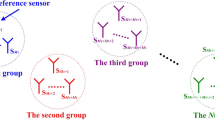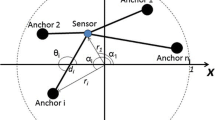Abstract
This paper investigates non coherent localization of an unknown target node in presence of a symmetrically opposite mirror node while the transmitter anchor node is perturbed under duress from external factors in a wireless sensor network. By limiting the transmitter anchor node translocation to a straight line, the resulting anchor-target geometry is exploited to mitigate the effects of mirror node and the perturbations of the transmitter node. Signal model for unperturbed and perturbed scenario is described. Fisher information vector expression is derived with respect to the polygonal geometry. Multistatic technique is utilized to extract fisher information from every possible link between the transmitter, receiver and unknown target node. The loss of location information due to undesirable aspect of the polygonal geometry is derived, following which a suitable expression is obtained to mitigate these effects. Solutions to algebraic functions involving perturbed anchor and symmetric geometry are developed. Geometric dilution of precision in terms of internodal angles is established. Numerical results corroborate theoretical analysis to achieve localization error comparable to sensor networks devoid of such perturbations.









Similar content being viewed by others
References
Isler, V., & Bajcsy, R. (2006). The sensor selection problem for bounded uncertainty sensing models. IEEE Transactions on Automation Science and Engineering, 3(4), 372–381. https://doi.org/10.1109/TASE.2006.876615
Dai, Z., Wang, G., Jin, X., & Lou, X. (2020). Nearly optimal sensor selection for TDOA-based source localization in wireless sensor networks. IEEE Transactions on Vehicular Technology, 9545(c), 1–1. https://doi.org/10.1109/tvt.2020.3011118
Yang, L., Gao, H., Ling, Y., Zhou, S., & Li, B. (2020). 3D joint estimation of position and velocity for a moving target in multistatic radar system by VHC-2WLS algorithm. IEEE Communications Letters, 7798(c), 1–1. https://doi.org/10.1109/lcomm.2020.2997829
Jia, M., Khattak, S. B. A., Guo, Q., Gu, X., & Lin, Y. (2019). Access point optimization for reliable indoor localization systems. IEEE Transactions on Reliability. https://doi.org/10.1109/TR.2019.2955748
Wang, J., Wang, G., Li, B., Yang, H., Hu, Y., & Schmeink, A. (2020). Massive MIMO two-way relaying systems with SWIPT in IoT networks. IEEE Internet of Things Journal, XX(X), 1–1. https://doi.org/10.1109/jiot.2020.3032446
Iliev, N., & Paprotny, I. (2015). Review and comparison of spatial localization methods for low-power wireless sensor networks. IEEE Sensors Journal, 15(10), 5971–5987. https://doi.org/10.1109/JSEN.2015.2450742
Nguyen, N. H., & Dogancay, K. (2016). Optimal geometry analysis for multistatic TOA localization. IEEE Transactions on Signal Processing, 64(16), 4180–4193. https://doi.org/10.1109/TSP.2016.2566611
Wu, Y. I., Wang, H., & Zheng, X. (2016). WSN localization using RSS in three-dimensional space—A geometric method with closed-form solution. IEEE Sensors Journal, 16(11), 4397–4404. https://doi.org/10.1109/JSEN.2016.2547444
Naseri, H., & Koivunen, V. (2017). Cooperative simultaneous localization and mapping by exploiting multipath propagation. IEEE Transactions on Signal Processing, 65(1), 200–211. https://doi.org/10.1109/TSP.2016.2616324
Wei, H. W., Peng, R., Wan, Q., Chen, Z. X., & Ye, S. F. (2010). Multidimensional scaling analysis for passive moving target localization with TDOA and FDOA measurements. IEEE Transactions on Signal Processing, 58(3), 1677–1688. https://doi.org/10.1109/TSP.2009.2037666
Xu, Y., Li, B., Zhao, N., Chen, Y., Wang, G., Ding, Z., & Wang, X. (2021). Coordinated direct and relay transmission with NOMA and network coding in Nakagami- m fading channels. IEEE Transactions on Communications, 69(1), 207–222. https://doi.org/10.1109/TCOMM.2020.3025555
Ghari, P. M., Shahbazian, R., & Ghorashi, S. A. (2019). Maximum entropy-based semi-definite programming for wireless sensor network localization. IEEE Internet of Things Journal, 6(2), 3480–3491. https://doi.org/10.1109/JIOT.2018.2885959
Hu, Y., & Leus, G. (2017). Robust differential received signal strength-based localization. IEEE Transactions on Signal Processing, 65(12), 3261–3276. https://doi.org/10.1109/TSP.2017.2684741
Li, B., Yang, J., Yang, H., Liu, G., Ma, R., & Peng, X. (2019). Decode-and-forward cooperative transmission in wireless sensor networks based on physical-layer network coding. Wireless Networks. https://doi.org/10.1007/s11276-019-02092-6
Feng, Y., & Li, H. X. (2020). Dynamic spatial-independent-component-analysis-based abnormality localization for distributed parameter systems. IEEE Transactions on Industrial Informatics, 16(5), 2929–2936. https://doi.org/10.1109/TII.2019.2900226
Zhang, Y., & Ho, D. (2020). Multistatic moving object localization by a moving transmitter of unknown location and offset. IEEE Transactions on Signal Processing, c, 1–1. https://doi.org/10.1109/TSP.2020.3008752
Ho, K. C., Lu, X., & Kovavisaruch, L. (2007). Source localization using TDOA and FDOA measurements in the presence of receiver location errors: Analysis and solution. IEEE Transactions on Signal Processing, 55(2), 684–696. https://doi.org/10.1109/TSP.2006.885744
Luo, C., Casaseca-De-La-Higuera, P., McClean, S., Parr, G., & Ren, P. (2018). Characterization of received signal strength perturbations using allan variance. IEEE Transactions on Aerospace and Electronic Systems, 54(2), 873–889. https://doi.org/10.1109/TAES.2017.2768278
Bayat, M., Crasta, N., Aguiar, A. P., & Pascoal, A. M. (2016). Range-based underwater vehicle localization in the presence of unknown ocean currents: Theory and experiments. IEEE Transactions on Control Systems Technology, 24(1), 122–139. https://doi.org/10.1109/TCST.2015.2420636
Aditya, S., Dhillon, H. S., Molisch, A. F., Buehrer, R. M., & Behairy, H. M. (2019). Characterizing the impact of SNR heterogeneity on time-of-arrival-based localization outage probability. IEEE Transactions on Wireless Communications, 18(1), 637–649. https://doi.org/10.1109/TWC.2018.2883726
Xiong, J., Cheong, J., Xiong, Z., Dempster, A. G., List, M., Woske, F., & Rievers, B. (2020). Carrier-phase-based multi-vehicle cooperative positioning using V2V sensors. IEEE Transactions on Vehicular Technology, 2(2), 1–1. https://doi.org/10.1109/tvt.2020.3004832
Shen, Y., Wymeersch, H., & Win, M. Z. (2010). Fundamental limits of wideband localization—Part II: Cooperative networks. IEEE Transactions on Information Theory, 56(10), 4981–5000. https://doi.org/10.1109/TIT.2010.2059720
Kilani, M. B., Gagnon, G., & Gagnon, F. (2018). Multistatic radar placement optimization for cooperative radar-communication systems. IEEE Communications Letters, 22(8), 1576–1579. https://doi.org/10.1109/LCOMM.2018.2837913
Morales, J. J., & Kassas, Z. M. (2018). Optimal collaborative mapping of terrestrial transmitters: receiver placement and performance characterization. IEEE Transactions on Aerospace and Electronic Systems, 54(2), 992–1007. https://doi.org/10.1109/TAES.2017.2773238
Oshman, Y., & Davidson, P. (1999). Optimization of observer trajectories for bearings-only target localization. IEEE Transactions on Aerospace and Electronic Systems, 35(3), 892–902. https://doi.org/10.1109/7.784059
Bayram, H., Hook, J. V., & Isler, V. (2016). Gathering bearing data for target localization. IEEE Robotics and Automation Letters, 1(1), 369–374. https://doi.org/10.1109/LRA.2016.2521387
Rui, L., & Ho, K. (2015). Efficient closed-form estimators for multistatic sonar localization. IEEE Transactions on Aerospace and Electronic Systems, 51(1), 600–614. https://doi.org/10.1109/TAES.2014.140482
Chen, L., Xiong, X., Liu, K., Wang, C., Zhou, W., Cheng, Y., & Liu, Y. (2014). POPA: Localising nodes by splitting PLA with nth-hop anchor neighbours. Electronics Letters, 50(13), 964–966. https://doi.org/10.1049/el.2013.4046
Liu, Y., Liu, H., Wang, L., & Bi, G. (2020). Target localization in high-coherence multipath environment based on low-rank decomposition and sparse representation. IEEE Transactions on Geoscience and Remote Sensing. https://doi.org/10.1109/tgrs.2020.2975218
Shoari, A., & Seyedi, A. (2014). On localization of a non-cooperative target with non-coherent binary detectors. IEEE Signal Processing Letters, 21(6), 746–750. https://doi.org/10.1109/LSP.2014.2314220
Vin, I., Gaillot, D. P., Laly, P., Lienard, M., & Degauque, P. (2014). Multipath component distance-based fingerprinting technique for non-cooperative outdoor localization in NLOS scenarios. IEEE Transactions on Antennas and Propagation, 62(9), 4794–4798. https://doi.org/10.1109/TAP.2014.2327142
Yang, Y., Zhao, Y., & Kyas, M. (2013). Weighted least-squares by bounding-box (B-WLS) for NLOS mitigation of indoor localization. IEEE Vehicular Technology Conference. https://doi.org/10.1109/VTCSpring.2013.6692811
Tomic, S., Beko, M., & Tuba, M. (2019). A linear estimator for network localization using integrated RSS and AOA measurements. IEEE Signal Processing Letters, 26(3), 405–409. https://doi.org/10.1109/LSP.2019.2892225
Guang, X., Fu, F. W., & Zhang, Z. (2016). Variable-rate linear network error correction MDS codes. IEEE Transactions on Information Theory, 62(6), 3147–3164. https://doi.org/10.1109/TIT.2016.2550522
Nesterov, Y., & Nemirovskii, A. (1994). Interior-point polynomial algorithms in convex programming. Interior-Point Polynomial Algorithms in Convex Programming. https://doi.org/10.1137/1.9781611970791
Zou, Y., & Liu, H. (2020). TDOA localization with unknown signal propagation speed and sensor position errors. IEEE Communications Letters, 24(5), 1024–1027. https://doi.org/10.1109/LCOMM.2020.2968434
Wang, T., Xiong, H., Ding, H., & Zheng, L. (2020). TDOA-based joint synchronization and localization algorithm for asynchronous wireless sensor networks. IEEE Transactions on Communications, 68(5), 3107–3124. https://doi.org/10.1109/TCOMM.2020.2973961
Author information
Authors and Affiliations
Corresponding author
Additional information
Publisher's Note
Springer Nature remains neutral with regard to jurisdictional claims in published maps and institutional affiliations.
Rights and permissions
About this article
Cite this article
Prateek, Arya, R. & Verma, A.K. Non-coherent localization with geometric topology of wireless sensor network under target and anchor node perturbations. Wireless Netw 27, 2271–2286 (2021). https://doi.org/10.1007/s11276-021-02575-5
Accepted:
Published:
Issue Date:
DOI: https://doi.org/10.1007/s11276-021-02575-5




